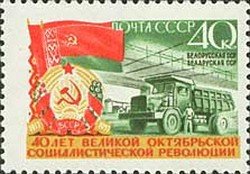Stamp: Byelorussian SSR, Truck (Soviet Union, USSR 1957)
Byelorussian SSR, Truck (Soviet Union, USSR 1957)
25 October (Soviet Union, USSR ) within release Anniversaries goes into circulation Stamp Byelorussian SSR, Truck face value 40 Russian kopek
| Stamp Byelorussian SSR, Truck in catalogues | |
|---|---|
| Michel: | Mi:SU 2004 |
Stamp is horizontal format.
Also in the issue Anniversaries:
- Stamp - 40th Anniv. of Great October Revolution - Russian SSR face value 40;
- Stamp - 40th Anniv. of Great October Revolution - Kirghiz SSR face value 40;
- Stamp - 40th Anniv. of Great October Revolution - Armenian SSR face value 40;
- Stamp - 40th Anniv. of Great October Revolution - Moldavian SSR face value 40;
- Stamp - Byelorussian SSR, Truck face value 40;
- Stamp - 40th Anniv. of Great October Revolution - Tajik SSR face value 40;
- Stamp - 40th Anniv. of Great October Revolution - Latvian SSR face value 40;
- Stamp - 40th Anniv. of Great October Revolution - Kazakh SSR face value 40;
- Stamp - 40th Anniv. of Great October Revolution - Turkmen SSR face value 40;
- Stamp - 40th Anniv. of Great October Revolution - Azerbaijani SSR face value 40;
- Stamp - 40th Anniv. of Great October Revolution - Georgian SSR face value 40;
- Stamp - 40th Anniv. of Great October Revolution - Lithuanian SSR face value 40;
- Stamp - 40th Anniv. of Great October Revolution - Uzbek SSR face value 40;
- Stamp - 40th Anniv. of Great October Revolution - Estonian SSR face value 40;
Stamp Byelorussian SSR, Truck it reflects the thematic directions:
A vehicle (from Latin: vehiculum) is a mobile machine that transports people or cargo. Typical vehicles include wagons, bicycles, motor vehicles (motorcycles, trucks, buses), railed vehicles (trains, trams), watercraft (ships, boats), aircraft and spacecraft. Land vehicles are classified broadly by what is used to apply steering and drive forces against the ground: wheeled, tracked, railed or skied. ISO 3833-1977 is the standard, also internationally used in legislation, for road vehicles types, terms and definitions.
A flag is a piece of fabric (most often rectangular or quadrilateral) with a distinctive design that is used as a symbol, as a signaling device, or as decoration. The term flag is also used to refer to the graphic design employed, and flags have since evolved into a general tool for rudimentary signalling and identification, especially in environments where communication is similarly challenging (such as the maritime environment where semaphore is used). National flags are patriotic symbols with varied wide-ranging interpretations, often including strong military associations due to their original and ongoing military uses. Flags are also used in messaging, advertising, or for other decorative purposes. The study of flags is known as vexillology, from the Latin word vexillum, meaning flag or banner.
A truck or lorry is a motor vehicle designed to transport freight, carry specialized payloads, or perform other utilitarian work. Trucks vary greatly in size, power, and configuration, but the vast majority feature body-on-frame construction, with a cabin that is independent of the payload portion of the vehicle. Smaller varieties may be mechanically similar to some automobiles. Commercial trucks can be very large and powerful and may be configured to be mounted with specialized equipment, such as in the case of refuse trucks, fire trucks, concrete mixers, and suction excavators. In American English, a commercial vehicle without a trailer or other articulation is formally a "straight truck" while one designed specifically to pull a trailer is not a truck but a "tractor"
A coat of arms is an heraldic visual design on an escutcheon (i.e. shield), surcoat, or tabard. The coat of arms on an escutcheon forms the central element of the full heraldic achievement which in its whole consists of shield, supporters, crest, and motto. A coat of arms is traditionally unique to an individual person, family (except in the United Kingdom), state, organisation or corporation.
An anniversary is the date on which an event took place or an institution was founded in a previous year, and may also refer to the commemoration or celebration of that event. For example, the first event is the initial occurrence or, if planned, the inaugural of the event. One year later would be the first anniversary of that event. The word was first used for Catholic feasts to commemorate saints. Most countries celebrate national anniversaries, typically called national days. These could be the date of independence of the nation or the adoption of a new constitution or form of government. The important dates in a sitting monarch's reign may also be commemorated, an event often referred to as a "Jubilee".





